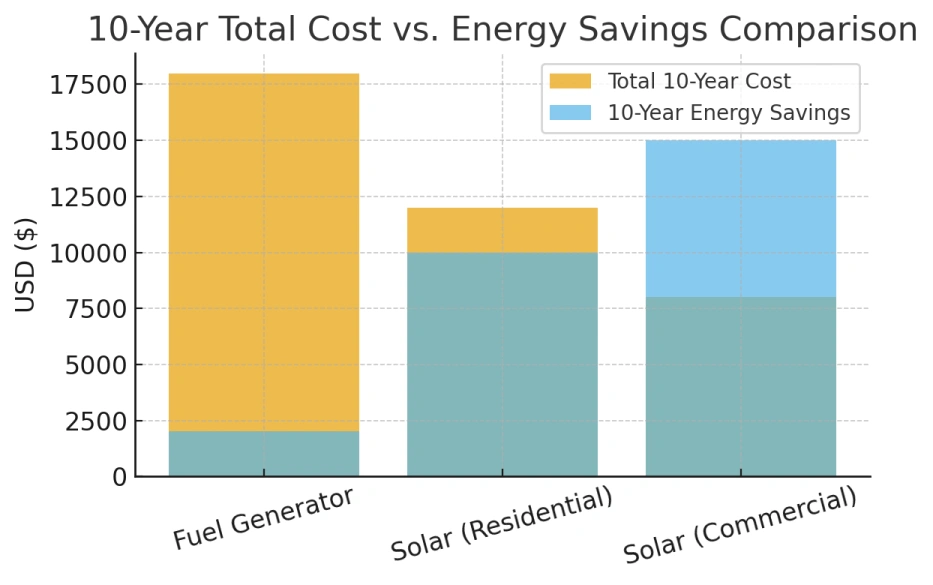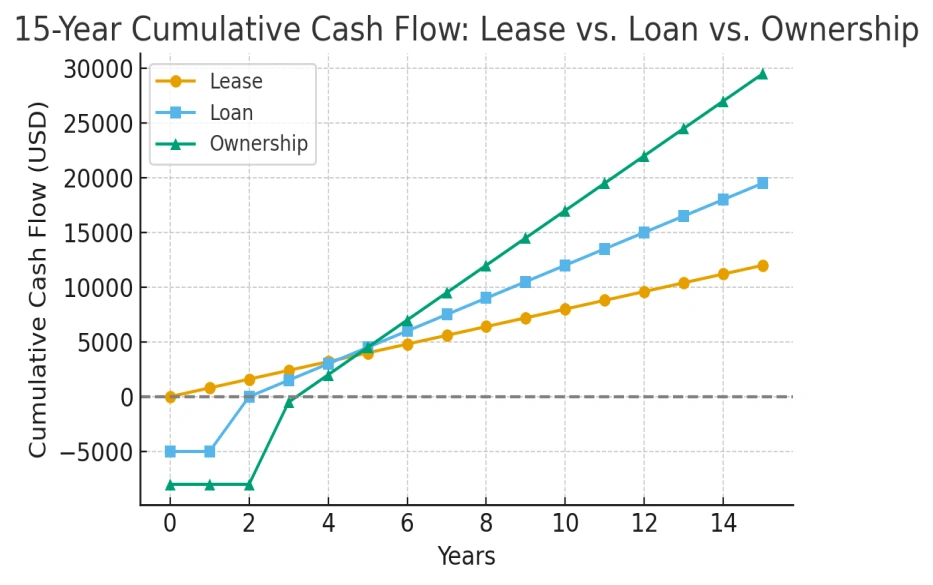
As global energy costs continue to rise, solar generator systems have emerged as a profitable alternative for homes, businesses, and remote operations. Yet one key question still drives investment decisions: how long does it take for a solar generator to pay for itself?
The answer depends on several factors — system size, power usage, financing model, and where the system is deployed. This article breaks down the true payback period across the most common use cases, helping investors and energy professionals understand where solar energy systems deliver the highest return on investment (ROI).
Understanding the Solar Payback Equation
Le solar payback period measures how long it takes for your system’s savings to equal its total cost. For solar generator systems — which combine PV panels, inverters, and lithium battery storage — this period typically ranges from 3 to 8 years, depending on use case and region.
Key variables affecting solar ROI:
- System cost and scale: Price per installed kWh and system capacity.
- Energy yield: Annual solar output and site irradiation levels.
- Electricity offset: How much grid power or diesel fuel is replaced.
- Financing structure: Cash, loan, or lease terms significantly affect payback speed.
- Incentives: Rebates, net-metering, and corporate tax credits reduce capital cost.
As the cost of lithium batteries and solar modules continues to decline, solar power systems now offer some of the shortest payback periods in renewable energy, often beating diesel or gas generators in both cost and reliability.
Chart 1: Comparative 10-Year Total Cost vs. Energy Savings

Residential Solar Generators: Savings Meet Self-Sufficiency
For homeowners, solar generator systems are both an energy security solution and a smart long-term investment. Modern residential solar backup systems typically combine rooftop solar panels with integrated lithium-ion batteries that store excess energy for nighttime or blackout use.
Average Payback Period: 5–8 Years
- Upfront Cost: $5,000–$12,000 depending on battery size and inverter rating.
- Annual Savings: 15–25% on electricity bills, depending on local rates.
- System Life: 15–20 years with minimal maintenance.
What accelerates ROI for households is the rising cost of grid electricity. In many regions, utility prices have increased by 8–12% annually — making self-generation more financially attractive than ever.
Another overlooked benefit: reduced maintenance and noise compared to fuel generators, along with zero fuel dependency.
Conseil de pro : Pairing solar generators with smart EMS (Energy Management Systems) can further optimize consumption and extend battery life, improving long-term savings.
Chart 2: Residential Solar Payback Curve (Cumulative Savings Over 10 Years)

Commercial & Industrial Systems: Fastest Payback, Strongest ROI
In the commercial solar market, payback is no longer just an energy calculation — it’s a strategic business decision. For manufacturing plants, logistics centers, and office buildings, solar generators deliver measurable savings while supporting corporate ESG and decarbonization goals.
Typical Payback Period: 3–6 Years
- CapEx Range: $40,000–$250,000 for 50–200 kW systems.
- Annual Electricity Offset: Up to 60% of total consumption.
- Operational Savings: $10,000–$30,000 per year depending on region.
Commercial entities benefit from economies of scale and government tax incentives, such as accelerated depreciation or feed-in tariffs. Moreover, many companies integrate solar generators for peak-shaving, using stored energy during high-tariff hours to reduce demand charges.
The ROI multiplies further when combined with les systèmes de stockage d'énergie par batterie (BESS) — allowing facilities to operate during grid failures and optimize load management.
In emerging markets with unreliable grids, solar hybrid systems replace costly diesel generation entirely, often cutting operating costs by 50–70% within a few years.
Chart 3: 15-Year Cumulative Cash Flow Comparison — Lease vs. Loan vs. Ownership

Off-Grid & Remote Applications: Longer Payback, Greater Freedom
For agricultural, construction, mining, and island communities, solar generators redefine energy accessibility. These systems may have slightly longer payback periods, but they offer energy independence and zero reliance on diesel logistics, making them invaluable for remote environments.
Average Payback Period: 6–9 Years
- Fuel Savings: Up to 80% compared to diesel generators.
- Maintenance Reduction: Fewer moving parts, longer service intervals.
- Lifespan: 15+ years with battery replacements after 8–10 years.
Consider a mining site using a 200 kW solar hybrid generator. Although the initial investment is higher, the site eliminates thousands of liters of diesel consumption per year, leading to lifetime savings exceeding $300,000 and a significant cut in CO₂ emissions.
Furthermore, solar systems can be scaled modularly — expanding capacity as operations grow without replacing core components.
Aperçu : Many rural electrification projects financed through development funds show positive net cash flow after Year 7, outperforming fossil alternatives over 20 years.
Beyond the Numbers: True Solar ROI
While financial payback is crucial, the real value of solar energy extends far beyond simple cost recovery. Businesses increasingly view solar systems as strategic sustainability assets that strengthen brand image, improve energy resilience, and hedge against volatile utility prices.
Key non-financial benefits include:
- Energy independence: Protection from fuel price fluctuations and grid instability.
- Carbon reduction: Each 10 kW solar system offsets roughly 13 tons of CO₂ annually.
- ESG compliance: Enhances corporate sustainability reporting and investor confidence.
- Operational resilience: Battery backup ensures continuity during blackouts or peak pricing hours.
By integrating smart inverters, remote monitoring, and AI-driven performance analytics, businesses can track real-time ROI and adjust usage to shorten the payback cycle.
Optional Visual: Pie chart showing financial vs. non-financial components of total solar ROI (60% savings, 25% energy security, 15% ESG/brand value).
Case Study Snapshot
Use Case: 100 kW hybrid solar generator for a logistics warehouse in Southeast Asia.
- Total Investment: $95,000
- Grid Tariff: $0.22 /kWh
- Annual Generation: 150,000 kWh
- Annual Savings: $33,000
- Payback Period: 2.9 years
- 25-Year Net Benefit: $520,000+
This example demonstrates how commercial solar generator systems are now competitive capital investments, delivering fast recovery and sustained returns over decades.
How Sunpal Energy Maximizes Your Solar Payback
Sunpal Energy designs and delivers high-performance solar generator systems tailored for every use case — from residential rooftops to industrial-scale microgrids. By combining advanced PV modules, hybrid inverters, lithium battery storage, and intelligent EMS platforms, Sunpal ensures the shortest possible payback and maximum lifetime yield.
Whether you need grid-tied solar backup, off-grid autonomyou hybrid energy storage, Sunpal’s engineering expertise guarantees cost-optimized performance backed by real data.
Conclusion
The real payback period of solar generator systems depends on application, scale, and financing — but across all scenarios, solar consistently outperforms traditional energy sources.
- Residential systems: 5–8 years average payback
- Commercial systems: 3–6 years
- Systèmes hors réseau: 6–9 years
Beyond the numbers, solar energy investments deliver resilience, sustainability, and long-term cost control. As technology costs decline and incentives expand, the financial case for solar generators has never been stronger.
Call to Action
Ready to calculate your real solar payback?
Talk to a Sunpal Energy expert today to discover your ideal system design, ROI projection, and total energy independence strategy.
